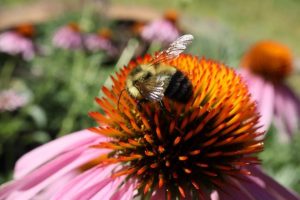
Standing in the garden, lulled by the hum of insects intent on collecting nectar while they still can, I’m enjoying the soft warmth of an autumn sun.
The season has clearly shifted from languid long days of summer to cool nights, shorter days and a sense there is no time to lose. It’s a time of abundance accompanied by reflection and assessment. What do I want to keep and nurture and what is ready to be released?
I think back over the garden’s production this past season, considering what will be maintained for next year, what won’t, what varieties are proving suitable, what is ready to reap.
These questions apply as much to my own phase of being as to the vegetables and fruits around me. The lessons of the garden reveal the lessons of my life. Working in the garden provides the immediate and accessible insights of this phase: the seasons, the patterns and the cycles.
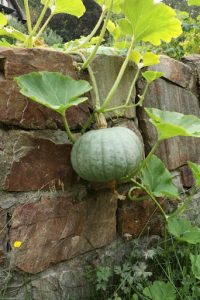
At 76 years old, I feel a particular resonance with autumn, a time of reaping lessons from decades of experience and learning, of ripening my understanding the way the round squash has matured from a soft ball to a firm and nutritiously dense vegetable that will contribute to meals in the coming months.
This process of assessment and reflection continues to evoke immense gratitude that I am part of the garden’s cycle and for the lessons it teaches. How fitting it is that much of the world celebrates this season of autumn with rituals of thanksgiving, when abundant growth comes to fruition. The garden reveals so many aspects that call forth appreciation.The food produced comes immediately to mind. Rich soil, cultivated for decades, nurtures the plants’ growth, a foundation for full tastes, healthy content and vibrant color. It provides the immense blessing of food that nourishes, that does not travel long distances before being consumed, that does not require packaging or unnatural treatments to preserve it.
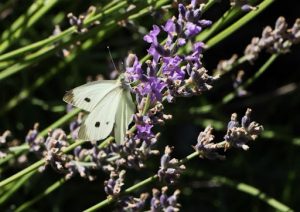
Our global community struggles with mountains of plastic and other waste, with loss of arable land, with the toxic consequences of applying pesticides, herbicides and chemical fertilizers; and with sickness and disease that in many cases could be prevented through a healthy diet. I recognize the value of one small effort like this garden to counter these detrimental actions. Small actions can have large outcomes.
The forest that surrounds the garden is home to numerous insects and creatures, but in the garden they are abundant far in excess of that habitat.
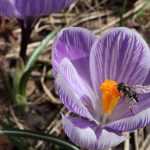
Although the global bee population is declining at a frightening rate, here there is sustenance for great numbers of them. Various butterflies flit blossom to blossom from spring to autumn. One of them, the white cabbage moth, lays its eggs in broccoli, cauliflower, kale and of course, cabbage. But there are also numerous wasps who eat the eggs as well as the small worms that manage to escape being devoured in the egg phase. These wasps keep the numbers of worms low. When gardeners act to eradicate wasps, there is need to use other efforts and means to get rid of the cabbage worms. Balance and harmony are disturbed.
Many gardeners lament slugs and mice in their garden. Here their numbers keep small, thanks to the generous feasting of snakes and other neighborhood predators. Because there are no pesticides, because I do not use what would poison these so-called nuisance creatures (and I confess that at times they are indeed a nuisance,) things tend to come into balance. It isn’t about perfection in the eradication of anything that might nibble on a lettuce leaf. It’s about learning how tolerance and diversity work. I see it here in the garden and understand how these qualities can also contribute to a balanced and harmonious world community that finds a way for all creatures to be valued and included in the part they play.
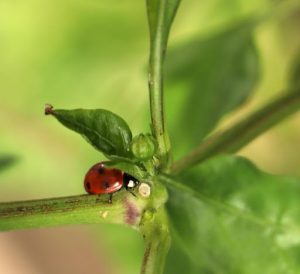
Letting go of ideas of perfection is good practice in my daily life and contributes to balance in the same way as it does in the cabbage or lettuce.
Many spiritual traditions and teachers extol beauty for its positive, uplifting, even transformative, influence. I think of the Navajo prayer, In Beauty I Walk, and of many
Sufi and Zen teachings that encourage the practice of creating beauty for the benefit it confers.
Dr. Zach Bush expresses the scope of it eloquently: If we make a conscious effort to elevate beauty in our work and our relationships, we can focus on doing our highest work and witnessing, with pleasure, the fabric of reality. John O’Donohue, Irish poet and philosopher, in his book, Divine Beauty, wrote: “Much of the stress and emptiness that haunts us can be traced back to our lack of attention to beauty.”
I cannot imagine being inattentive to beauty in the garden, for it is there before me in whatever direction I look. Caught by light, an onion skin becomes ruby brilliance, or veins on a chard leaf unfold like the branches of a birch tree, while the glistening webbed wings of a bee reveal iridescent mystery. These moments suspend my thoughts and sometimes breath as I gaze in wonder at the fullness of being revealed.
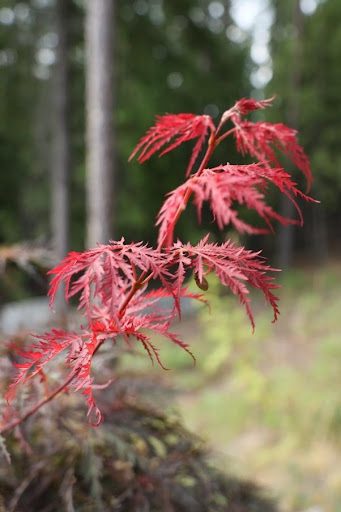
And something more, as if my heart has been pierced and I am changed by being witness to beauty, given a glimpse of another possibility.
Moments of beauty bring me fully to the present. The well-known Buddhist monk and teacher, Thich Nhat Hahn, wrote: “Our true home is in the present moment. To live in the present moment is a miracle.” Having the blessing of a garden reveals this miracle, over and over, until the presence of beauty is everywhere. The various practices meant to bring awareness to the present, such as meditation, hatha yoga, qi gong, journal reflections and prayer, can include the garden as a means to develop conscious awareness of the now.
Philosophers and psychologists have characterized our modern world and its ills as evidence of a crisis of meaning. Rituals and connections that once infused meaning into our lives have been abandoned along with the meaning they provided. Yet people who find their way to tending a garden repeatedly express the satisfaction it gives.
Neurologist and writer, Oliver Sacks, noted: “The effects of nature’s qualities on health are not only spiritual and emotional but physical and neurological. I have no doubt that they reflect deep changes in the brain’s physiology, and perhaps even its structure.”
The process of interacting with soil, plants and animals provides a community of relationships with other living beings that becomes a lived experience of the interconnectedness of life. A felt connection to this entire living world is restored.
An indigenous elder, Chief Sealth, prophesied the great loneliness that would befall humans as we lost the awareness of our kinship with nature. The garden restores awareness of this connection, of our shared relationship with all life. During the early times of the Covid pandemic, I heard people speak of their pain in the loss of community. Yet as time passed, voices expressed unforeseen positive outcomes from their increased isolation. Particularly noted were connections with the natural world that people had been too busy to notice or feel before the limitations of the pandemic forced their change in behaviour.
The community and connection with the natural world emerged as more sustaining than had been previously experienced and with a deeper capacity to bring fulfillment. As the writer Barry Lopez observed: “One of the reasons we’re lonely is that we’ve cut ourselves off from the non-human world and have called this progress.”
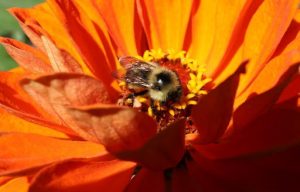
The bees continue humming, the autumn light intensifies the brilliant red and gold of zinnia petals and I resume gently digging potatoes for hearty winter meals.
My determination to continue to support and nurture the life of this garden is strong. The life of the garden and my life are deeply intertwined. The words of the medieval Zen monk gardener Muso Soseki reverberate: “One who distinguishes between the garden and the practice cannot be said to have found the way.”

Alanda Greene lives in the Kootenay Bay, British Columbia, Canada. Having a deep connection with nature, she and her husband built their house of stone and timber overlooking a terraced garden, and integrated their life into this rural community. Alanda’s primary focus is the conscious integration of spirit with all aspects of life. Books by Alanda.
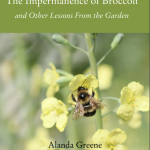
Her new book The Impermanence of Broccoli and Other Lessons From the Garden, can be purchased/ordered from the Ashram gift store.
